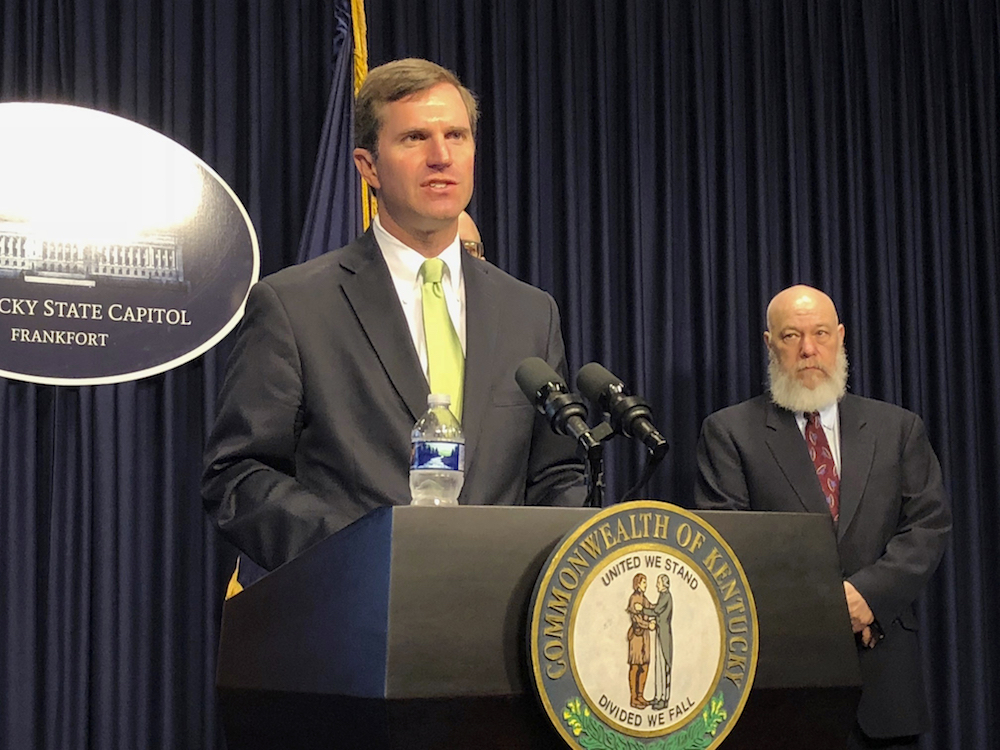
Kentucky Gov. Andy Beshear discusses developments in Kentucky regarding the new coronavirus at a news briefing in March
These days, if it’s 4:59 in Kentucky, people across the state are racing to tune in.
No matter the local news carrier — from Pikeville in the east to Paducah in the west—it’s pretty much a given that your television, my television, and our neighbors’ televisions will be flipping over to Governor Andy Beshear’s broadcast for his daily update about how the Covid-19 pandemic is impacting Kentuckians; or as Beshear frequently describes the events, “Our daily 5 o’clock get-togethers.”
Sandwiched between regular local coverage, these press conferences have proven to be overwhelmingly popular with and informative for Kentuckians, already spawning plenty of fan-made merchandise and (as you might imagine) memes, upon memes, upon memes. Admirers from other states are now even offering up some pretty enticing, if wild, bribes to lure Beshear over to their neck of the woods and serve as governor for a while, including an unlimited supply of Vidalia onions from Georgia and — from some very generous folks in Florida — the entirety of Walt Disney World plus a lifetime supply of stone crabs.
From my den of self-isolation (while simultaneously trying to figure out how to report remotely, write coherent stories, and wrangle a 13-month-old), knowing that so many diverse people across the state are watching local news right now — even if primarily for Beshear’s updates — fills me with at least a modicum of hope. What lifts my spirits even more, though, is that these gubernatorial chats (or #AfternoonswithAndy, as one hashtag goes) hold great appeal because they take a lot of their cues from what local journalists do every, single day: give communities the honest, direct, and thoughtful facts they need during difficult times.
Beshear’s chats most often begin with photos or stories from social media about positive ways that Kentucky counties, cities, and individuals are weathering these isolated, uncertain days. In small towns across the state, reporters (particularly those who are in places that often fall victim to negative parachute journalism) have long taken up this mantle in a similar fashion as a form of solutions journalism: reporting on how people are actively responding to problems and issues in their community.
Since the beginning of the coronavirus pandemic, for example, my hometown paper, the Richmond Register (Richmond, Kentucky) has been keeping the community up-to-date about how bus drivers and cafeteria workers have stepped up locally to ensure no students will go hungry or miss a meal even though school is canceled for the foreseeable future. When faced with an ostensibly endless cascade of bad news, it’s these pieces that often remind people of the good work going on (seemingly) behind the scenes.
Because it’s undeniable that there are plenty of scary changes and hard truths to hear right now. That’s why Beshear has been calling in the experts: relying on Kentucky health officials, doctors, and scientists to help lead the way in these daily addresses to curb the spread of misinformation. You know who else loves getting accurate, factual, expert information straight from the source? That’s right — local journalists. If you’re a Kentuckian who has heard a rumor floating around that local doctors might be hoarding a drug that could prevent Covid-19, for example, look no further than newspapers like the Lexington Herald-Leader to dispel that myth. These reporters have dedicated their lives to ensuring the people in their communities have honest, transparent information at their fingertips — and don’t plan on stopping anytime soon.
And while it shouldn’t be surprising to see public figures touting solid journalism as both reliable information and critical to public well-being, well, here we are. The use of evidence-based journalism as a point of reference during these “fireside chats” has been a breath of fresh air. Thus far in Kentucky, one of the most well-worn pieces of data employed by Beshear has been a graph from The Washington Post showing how St. Louis fared versus Philadelphia in “flattening the curve” during the spread of the Spanish Flu in 1918. And while for most viewers the primary takeaway is that Kentucky needs to be like St. Louis (spoiler: they flattened the curve), for me, it’s that journalism is being given the respect it deserves not only as an outlet for breaking news, but a way to better understand how history, science, and public health can better inform our decisions now. We need that more than ever here in Kentucky.
During a recent address, Beshear asked everyone to step up at 10 a.m. each day and ring a bell to let other people know “that we are out here and that we care about them.” It was a sentiment close to my heart as a reporter, particularly as someone who has worked diligently to tell the stories of vulnerable populations and issues that are all-too-frequently overlooked.
But it’s not just me. Local Kentucky journalists have been ringing the bells for their communities to hear for decades: through layoffs and shutdowns and budget cuts so deep they gnawed on the bone. They’ve been ringing their bells to tell their community stories even when their neighbors didn’t want to hear — when it seemed like no one was listening.
And rest assured, as I ring my bell today at 10 a.m., I’ll be thinking of journalists across the state who are also hoping that, as Kentuckians have warmly embraced a new tradition of daily information during these trying times, they’ll remember how good it felt to be informed and armed with facts once the need for these 5 o’clock get-togethers is over. And maybe, they’ll subscribe to their local newspaper.

